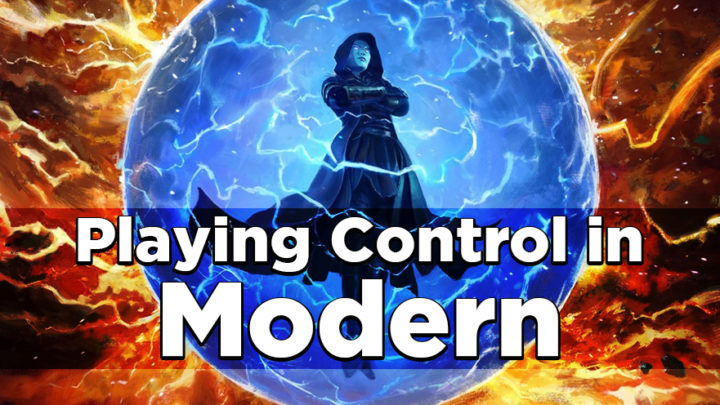If you were playing Modern before the release of War of the Spark and Modern Horizons, you may not think that putting Cryptic Command in your deck is a winning strategy. Modern decks have long been built for speed and efficiency, and tapping out for a Cryptic Command could often leave control players in a tenuous spot. You’d usually be trading down on mana, and your opponent could simply cast another powerful spell after you countered the first one.

Luckily — or unluckily, depending on how you feel about Cryptic Command — things have changed. Now, Cryptic Command decks seem to be running the (virtual) tables in Modern. How did that happen?
There are a few factors at play here: recently-printed cards that have increased blue’s power level, changes to the way decks are built, and changes to the Modern metagame overall. Let’s break it all down.
In With The New
It is no secret that War of the Spark and the sets that came after it included some very powerful cards for blue decks. Just look at all these recent cards that have made their way into Modern:
- Teferi, Time Raveler
- Uro, Titan of Nature’s Wrath
- Aether Gust
- Force of Negation
- Growth Spiral
- Field of the Dead
- Mystic Sanctuary
- Dovin’s Veto
- Archmage’s Charm
- Shark Typhoon
- Mystical Dispute
- Ashiok, Dream Render
Twelve is a staggering number of new cards for any Modern archetype to get in the span of fifteen months…and those are just the cards that see play the decks I’m covering today. Urza, Lord High Artificer and Ice-Fang Coatl were also popular for a long time before Mox Opal and Arcum’s Astrolabe were banned. No wonder blue midrange decks are finally finding success!
The cards on this list aren’t just powerful: they also cover a lot of bases. Blue has gained efficient interactive spells, hate cards for popular archetypes and, most importantly, a variety of new win conditions.
Winning the Game Without Trying
For much of their time in Modern, blue control decks’ win conditions were limited to cards with high mana costs. While Elspeth, Sun’s Champion and Entreat the Angels are powerful enough to win games outright, they were painful to draw early in the game. If the control player stumbled, their opponent could easily find the window they needed to win the game.

Things started changing when Jace, the Mind Sculptor was unbanned in 2018. Jace has been the gold standard for control decks for many years: a card that provides card advantage and utility that can also win the game if left unchecked. When you have cards like Jace in your deck, you don’t have to try as hard to win the game; as long as you can keep interacting with your opponent and keep Jace alive, you’ll eventually get there. The only problem is that Jace costs four mana, and he isn’t great when you have to go shields-down against opponents who can exploit that opportunity.
Shark Typhoon

Shark Typhoon is a much more versatile win condition. A-six mana enchantment may not seem like a card Modern decks are interested in, but I assure you, you won’t cast it very often. A cycled Shark Typhoon is virtually uncounterable, and should the shark token die, you still got a card out of it.
The best thing about Shark Typhoon is that it scales with the game: the longer the game lasts, the more mana you have, so you can create a big enough shark to win the game (or make a medium-sized shark and still cast other spells). It’s also an especially useful option in decks that play lots of counterspells. Like Vendilion Clique and Brazen Borrower, an end-step shark is a great way to out-tempo an opponent who played around a counterspell.
Field of the Dead

If there’s one thing I’ve learned in the last year, it’s that lands with spell-like effects are often far better than they look. The Horizon lands are a great example of this: they look unassuming, but they reduce the impact of flooding in several different archetypes.
Field of the Dead is powerful for a similar reason: it will eventually win you the game for a very low cost, and it doesn’t cost you a card slot that you’d otherwise use for interaction. The inevitability that Field of the Dead provides relative to its opportunity cost is unmatched, especially in a Bant shell, where Uro, Titan of Nature’s Wrath and Hour of Promise can turbo-charge the zombie army.
Uro, Titan of Nature’s Wrath

Finally we have Uro, Titan of Nature’s Wrath: a card so ubiquitous in tournament Magic that it needs no introduction. In addition to winning games on its own, Uro takes a ton of pressure off both your life total and mana development, which makes other win conditions like Shark Typhoon and Field of the Dead even stronger. The lock of Cryptic Command + Mystic Sanctuary + Uro is not only easy to establish, but will make sure you win in short order.
The Decks
Azorius Sharkblade by Danker

2 Teferi, Time Raveler
3 Snapcaster Mage
4 Stoneforge Mystic
3 Archmage’s Charm
2 Cryptic Command
3 Force of Negation
2 Mana Leak
4 Opt
4 Path to Exile
2 Spell Snare
1 Batterskull
1 Sword of Feast and Famine
1 Sword of Fire and Ice
4 Shark Typhoon
1 Celestial Colonnade
4 Field of Ruin
4 Flooded Strand
3 Hallowed Fountain
5 Island
1 Misty Rainforest
2 Mystic Sanctuary
2 Plains
1 Polluted Delta
1 Scalding Tarn
SIDEBOARD
3 Aether Gust
2 Celestial Purge
3 Ceremonious Rejection
1 Condemn
1 Detention Sphere
1 Disdainful Stroke
1 Supreme Verdict
2 Timely Reinforcements
1 Vendilion Clique
Azorius Sharkblade is my baseline for blue-based midrange decks. Its classic build features a suite of counterspells that are all powerful in different situations and at different points in the game. Spell Snare, Cryptic Command and the rest ensure that you have all your bases covered; you even get a nice “free” option of Force of Negation for added protection.
Backing up the counters are some midrange haymakers in the Stoneforge Mystic package, plus our old friend Shark Typhoon. Of the blue midrange decks in Modern, Azorius Sharkblade is typically the fastest at ending the game.
Bant Control by Kanister

1 Jace, the Mind Sculptor
2 Teferi, Hero of Dominaria
3 Teferi, Time Raveler
1 Snapcaster Mage
4 Uro, Titan of Nature’s Wrath
3 Wall of Omens
1 Aether Gust
3 Cryptic Command
3 Force of Negation
2 Growth Spiral
1 Hour of Promise
2 Mana Leak
4 Path to Exile
1 Remand
1 Spell Snare
1 Supreme Verdict
2 Breeding Pool
2 Field of Ruin
2 Field of the Dead
4 Flooded Strand
1 Forest
1 Hallowed Fountain
2 Island
4 Misty Rainforest
2 Mystic Sanctuary
1 Prairie Stream
1 Seaside Citadel
1 Snow-Covered Forest
2 Snow-Covered Island
1 Snow-Covered Plains
1 Temple Garden
SIDEBOARD
2 Aether Gust
1 Ashiok, Dream Render
1 Celestial Purge
2 Ceremonious Rejection
2 Dovin’s Veto
1 Elder Gargaroth
1 Isolate
1 Ravenous Trap
1 Supreme Verdict
1 Timely Reinforcements
2 Veil of Summer
Bant Control was the most dominant deck in Modern while Arcum’s Astrolabe was legal, and it may soon regain that status. In lieu of the equipment package found in Azorius, Bant opts to bolster its Planeswalker roster with Jace, the Mind Sculptor and Teferi, Hero of Dominaria — two excellent sources of card advantage that will eventually end the game.
Adding green grants access to Uro and Veil of Summer, as well as Growth Spiral and Hour of Promise to bring Field of the Dead online quickly. However, any three-color Field of the Dead deck will have strict color requirements that strain its mana base. Bant therefore loses access to Field of Ruin, which can hurt its match-ups against “big mana” strategies.
Temur Control by Lavaridge

1 Wrenn and Six
1 Snapcaster Mage
4 Uro, Titan of Nature’s Wrath
1 Archmage’s Charm
3 Cryptic Command
4 Fact or Fiction
3 Force of Negation
4 Growth Spiral
4 Lightning Bolt
1 Nexus of Fate
4 Remand
1 Shark Typhoon
2 Wilderness Reclamation
1 Blast Zone
2 Breeding Pool
1 Castle Vantress
1 Field of Ruin
2 Field of the Dead
1 Forest
2 Island
1 Ketria Triome
4 Misty Rainforest
1 Mountain
2 Mystic Sanctuary
4 Scalding Tarn
1 Snow-Covered Forest
1 Snow-Covered Island
1 Steam Vents
1 Stomping Ground
1 Wooded Foothills
SIDEBOARD
1 Abrade
4 Aether Gust
1 Ancient Grudge
2 Anger of the Gods
1 Ashiok, Dream Render
1 Ceremonious Rejection
1 Flame Slash
1 Mystical Dispute
1 Ravenous Trap
1 Veil of Summer
1 Wrenn and Six
The Temur version of this deck trades in Path to Exile and Teferi for Lightning Bolt and Wrenn and Six. Wrenn and Six helps you avoid missing land drops — critical for any control deck — and becomes a powerful engine that supports Field of the Dead and Shark Typhoon.
Burn spells and Uro give Temur an edge against aggressive decks such as Prowess, while Wilderness Reclamation and Nexus of Fate go over the top of other blue decks. Normally, a deck like this would be vulnerable to a strong midrange strategy, but Uro makes up so much ground by being the best midrange card in Modern. You’ll also find the Uro + Mystic Sanctuary + Cryptic Command loop here, which will allow you to transition quickly into the late game.
Sultai Control by Jedrek Szymd

3 Opt
1 Spell Snare
2 Cling to Dust
4 Fatal Push
1 Dismember
2 Mana Leak
2 Remand
3 Snapcaster Mage
3 Tarmogoyf
1 Abrupt Decay
3 Force of Negation
1 Archmage’s Charm
4 Uro, Titan of Nature’s Wrath
3 Jace, the Mind Sculptor
2 Cryptic Command
2 Breeding Pool
2 Field of Ruin
1 Flooded Strand
2 Forest
3 Island
4 Misty Rainforest
3 Mystic Sanctuary
4 Polluted Delta
1 Swamp
2 Watery Grave
1 Zagoth Triome
SIDEBOARD
3 Aether Gust
1 Shark Typhoon
1 Vendilion Clique
1 Scavenging Ooze
2 Collector Ouphe
2 Veil of Summer
1 Ashiok, Dream Render
1 Notion Thief
1 Assassin’s Trophy
1 Abrupt Decay
1 Engineered Explosives
Our final stop on the Big Blue train is Sultai Midrange. Much of the same elements are present here, including Uro, Mystic Sanctuary, and Cryptic Command. In addition to the classic combo and the counterspell suite, Jedrek has chosen to forgo main deck Shark Typhoon in favor of the consistent board presence of Tarmogoyf. The additional Fatal Pushes and Abrupt Decays tell us that Jedrek is trying to win midrange battles against decks that can’t go quite as big.
Sultai’s philosophy is similar to Jund’s: interact early and often while making sure to have a smooth and consistent draw, then stick a Jace or an Uro to seal the deal. The sideboard is also full of value; in addition to disrupting the opponent, you can also apply pressure to end the game before they have a chance to regain their footing.
Conclusion
Wow, Cryptic Command really got busy lately! The current Modern metagame is a refreshing departure from the days of blistering-fast aggro and combo decks. I for one enjoy that so many different blue decks are viable, and I’m excited to see how players continue to innovate on the archetype. Modern is as slow and interactive as I can remember it right now, which is perfect for the continued growth of the big blue strategy. As always, if you have any questions or comments, feel free to reach out to me on Twitter at @RappaciousOne.

Michael Rapp is a Modern specialist who favors Thoughtseize decks. Magic sates his desire for competition and constant improvement.

